Assignment Title: Investigating the Genetic Factors of Dyslexia
VerifiedAdded on 2019/09/16
|11
|2214
|282
Report
AI Summary
The article discusses the genetic factors that contribute to dyslexia, a reading disability characterized by difficulties with decoding, fluency, and comprehension. Research suggests that dyslexia is a complex trait influenced by multiple genes, including DCDC2, which has been linked to reading and language impairment. The magnocellular theory proposes that deficits in visual processing and attention contribute to dyslexia. The article also mentions comorbidities with ADHD and hemianopic dyslexia, as well as the importance of early identification and intervention to mitigate its effects.
Contribute Materials
Your contribution can guide someone’s learning journey. Share your
documents today.

Student Name
[Course title]
Dyslexia
[Course title]
Dyslexia
Secure Best Marks with AI Grader
Need help grading? Try our AI Grader for instant feedback on your assignments.
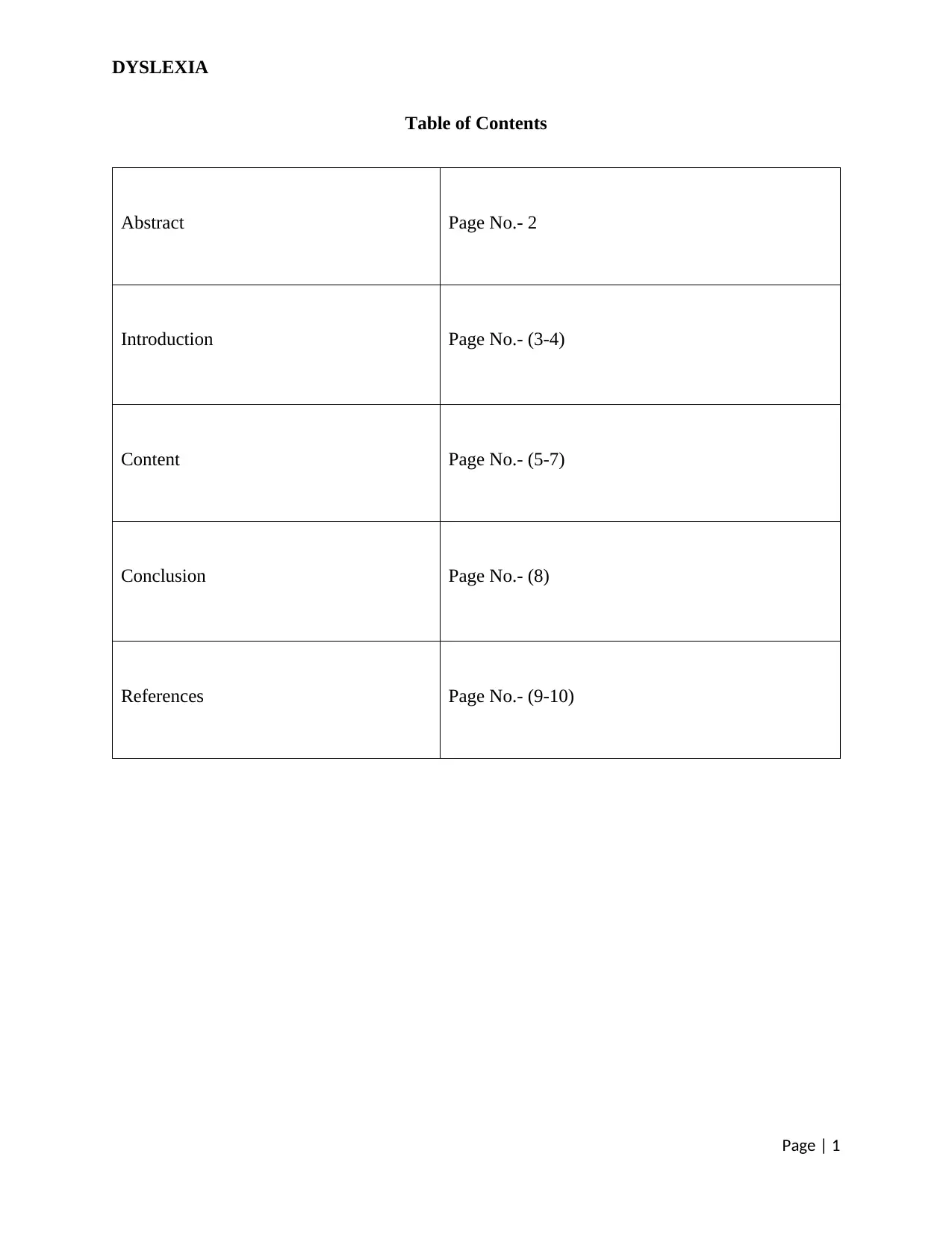
DYSLEXIA
Table of Contents
Abstract Page No.- 2
Introduction Page No.- (3-4)
Content Page No.- (5-7)
Conclusion Page No.- (8)
References Page No.- (9-10)
Page | 1
Table of Contents
Abstract Page No.- 2
Introduction Page No.- (3-4)
Content Page No.- (5-7)
Conclusion Page No.- (8)
References Page No.- (9-10)
Page | 1
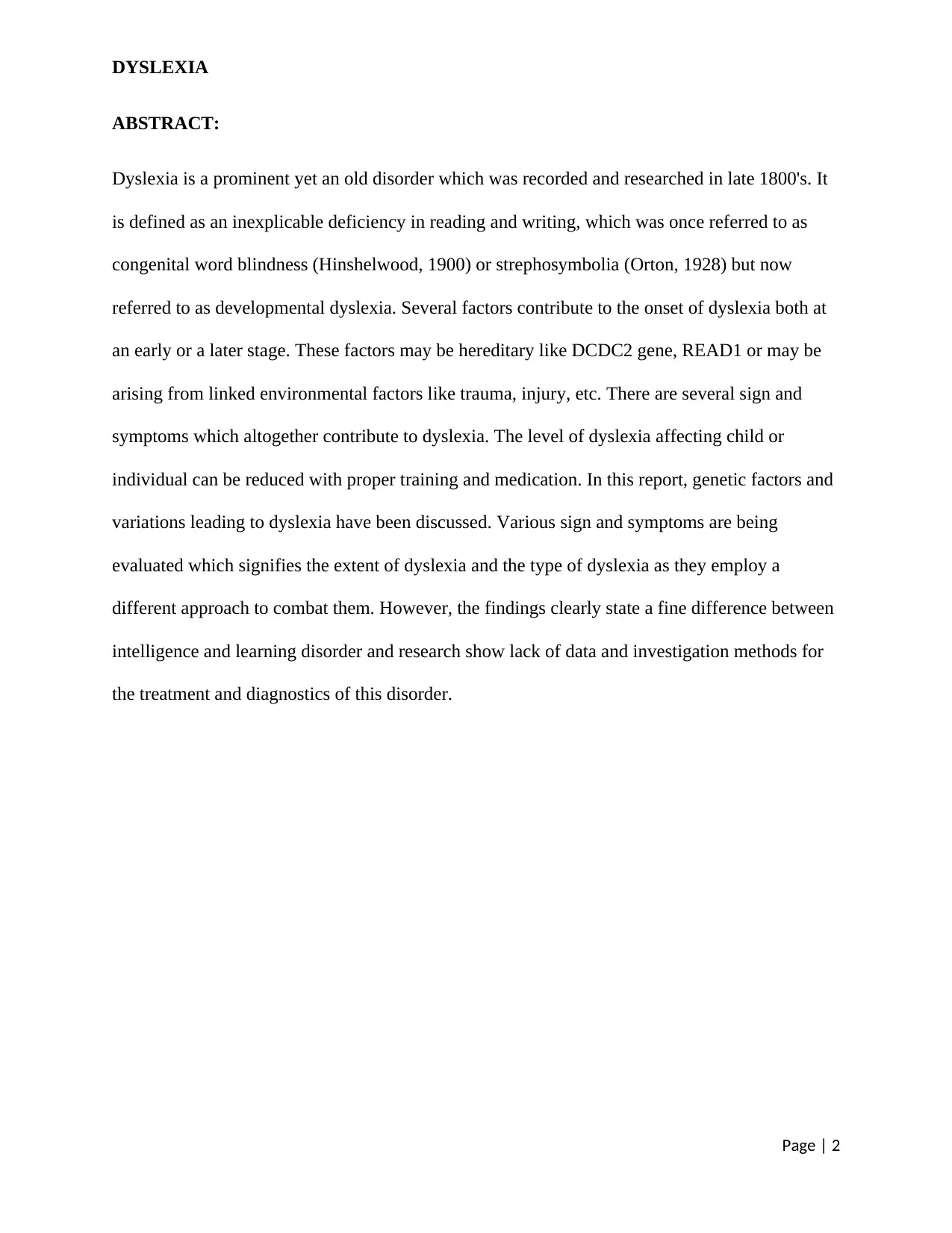
DYSLEXIA
ABSTRACT:
Dyslexia is a prominent yet an old disorder which was recorded and researched in late 1800's. It
is defined as an inexplicable deficiency in reading and writing, which was once referred to as
congenital word blindness (Hinshelwood, 1900) or strephosymbolia (Orton, 1928) but now
referred to as developmental dyslexia. Several factors contribute to the onset of dyslexia both at
an early or a later stage. These factors may be hereditary like DCDC2 gene, READ1 or may be
arising from linked environmental factors like trauma, injury, etc. There are several sign and
symptoms which altogether contribute to dyslexia. The level of dyslexia affecting child or
individual can be reduced with proper training and medication. In this report, genetic factors and
variations leading to dyslexia have been discussed. Various sign and symptoms are being
evaluated which signifies the extent of dyslexia and the type of dyslexia as they employ a
different approach to combat them. However, the findings clearly state a fine difference between
intelligence and learning disorder and research show lack of data and investigation methods for
the treatment and diagnostics of this disorder.
Page | 2
ABSTRACT:
Dyslexia is a prominent yet an old disorder which was recorded and researched in late 1800's. It
is defined as an inexplicable deficiency in reading and writing, which was once referred to as
congenital word blindness (Hinshelwood, 1900) or strephosymbolia (Orton, 1928) but now
referred to as developmental dyslexia. Several factors contribute to the onset of dyslexia both at
an early or a later stage. These factors may be hereditary like DCDC2 gene, READ1 or may be
arising from linked environmental factors like trauma, injury, etc. There are several sign and
symptoms which altogether contribute to dyslexia. The level of dyslexia affecting child or
individual can be reduced with proper training and medication. In this report, genetic factors and
variations leading to dyslexia have been discussed. Various sign and symptoms are being
evaluated which signifies the extent of dyslexia and the type of dyslexia as they employ a
different approach to combat them. However, the findings clearly state a fine difference between
intelligence and learning disorder and research show lack of data and investigation methods for
the treatment and diagnostics of this disorder.
Page | 2
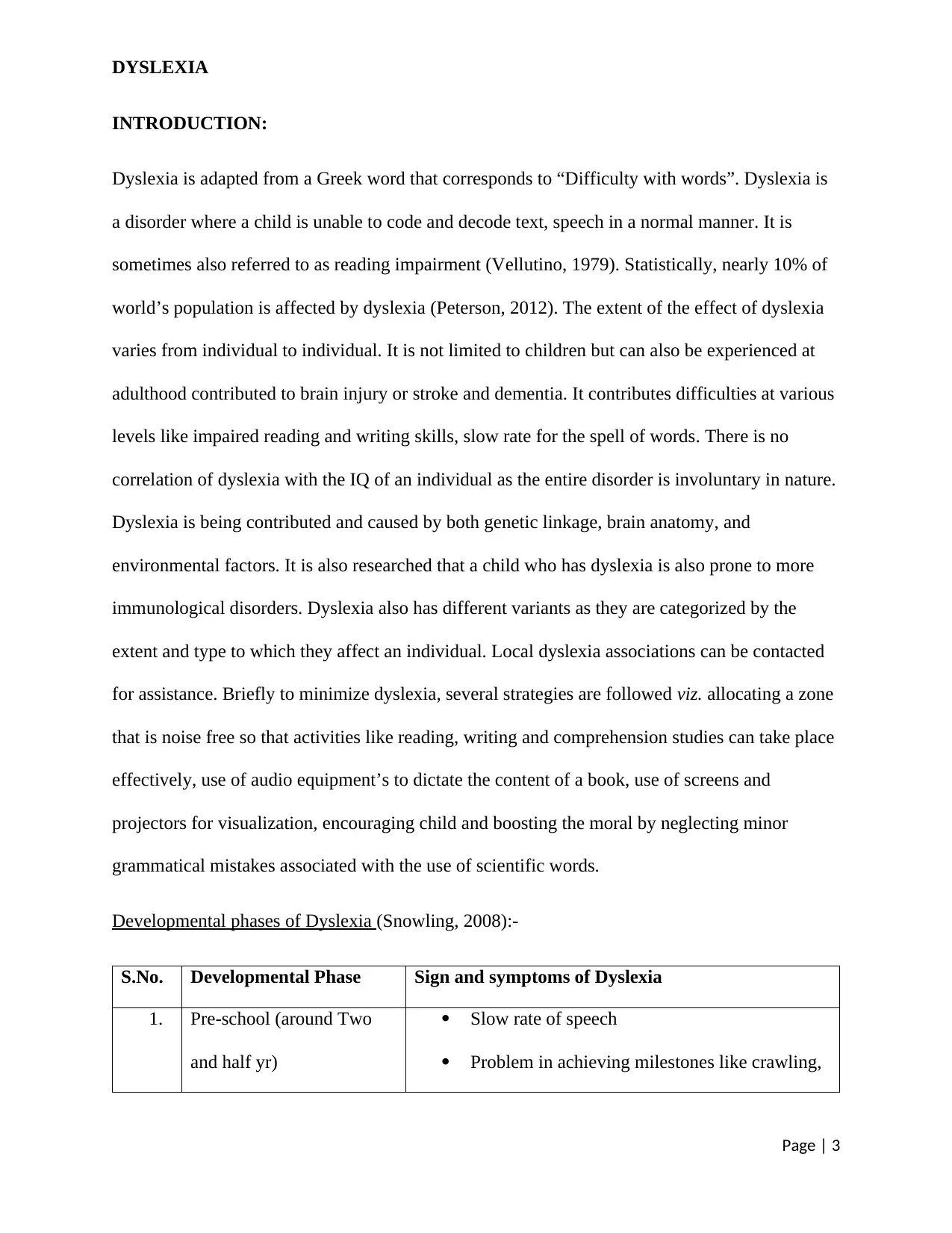
DYSLEXIA
INTRODUCTION:
Dyslexia is adapted from a Greek word that corresponds to “Difficulty with words”. Dyslexia is
a disorder where a child is unable to code and decode text, speech in a normal manner. It is
sometimes also referred to as reading impairment (Vellutino, 1979). Statistically, nearly 10% of
world’s population is affected by dyslexia (Peterson, 2012). The extent of the effect of dyslexia
varies from individual to individual. It is not limited to children but can also be experienced at
adulthood contributed to brain injury or stroke and dementia. It contributes difficulties at various
levels like impaired reading and writing skills, slow rate for the spell of words. There is no
correlation of dyslexia with the IQ of an individual as the entire disorder is involuntary in nature.
Dyslexia is being contributed and caused by both genetic linkage, brain anatomy, and
environmental factors. It is also researched that a child who has dyslexia is also prone to more
immunological disorders. Dyslexia also has different variants as they are categorized by the
extent and type to which they affect an individual. Local dyslexia associations can be contacted
for assistance. Briefly to minimize dyslexia, several strategies are followed viz. allocating a zone
that is noise free so that activities like reading, writing and comprehension studies can take place
effectively, use of audio equipment’s to dictate the content of a book, use of screens and
projectors for visualization, encouraging child and boosting the moral by neglecting minor
grammatical mistakes associated with the use of scientific words.
Developmental phases of Dyslexia (Snowling, 2008):-
S.No. Developmental Phase Sign and symptoms of Dyslexia
1. Pre-school (around Two
and half yr)
Slow rate of speech
Problem in achieving milestones like crawling,
Page | 3
INTRODUCTION:
Dyslexia is adapted from a Greek word that corresponds to “Difficulty with words”. Dyslexia is
a disorder where a child is unable to code and decode text, speech in a normal manner. It is
sometimes also referred to as reading impairment (Vellutino, 1979). Statistically, nearly 10% of
world’s population is affected by dyslexia (Peterson, 2012). The extent of the effect of dyslexia
varies from individual to individual. It is not limited to children but can also be experienced at
adulthood contributed to brain injury or stroke and dementia. It contributes difficulties at various
levels like impaired reading and writing skills, slow rate for the spell of words. There is no
correlation of dyslexia with the IQ of an individual as the entire disorder is involuntary in nature.
Dyslexia is being contributed and caused by both genetic linkage, brain anatomy, and
environmental factors. It is also researched that a child who has dyslexia is also prone to more
immunological disorders. Dyslexia also has different variants as they are categorized by the
extent and type to which they affect an individual. Local dyslexia associations can be contacted
for assistance. Briefly to minimize dyslexia, several strategies are followed viz. allocating a zone
that is noise free so that activities like reading, writing and comprehension studies can take place
effectively, use of audio equipment’s to dictate the content of a book, use of screens and
projectors for visualization, encouraging child and boosting the moral by neglecting minor
grammatical mistakes associated with the use of scientific words.
Developmental phases of Dyslexia (Snowling, 2008):-
S.No. Developmental Phase Sign and symptoms of Dyslexia
1. Pre-school (around Two
and half yr)
Slow rate of speech
Problem in achieving milestones like crawling,
Page | 3
Paraphrase This Document
Need a fresh take? Get an instant paraphrase of this document with our AI Paraphraser
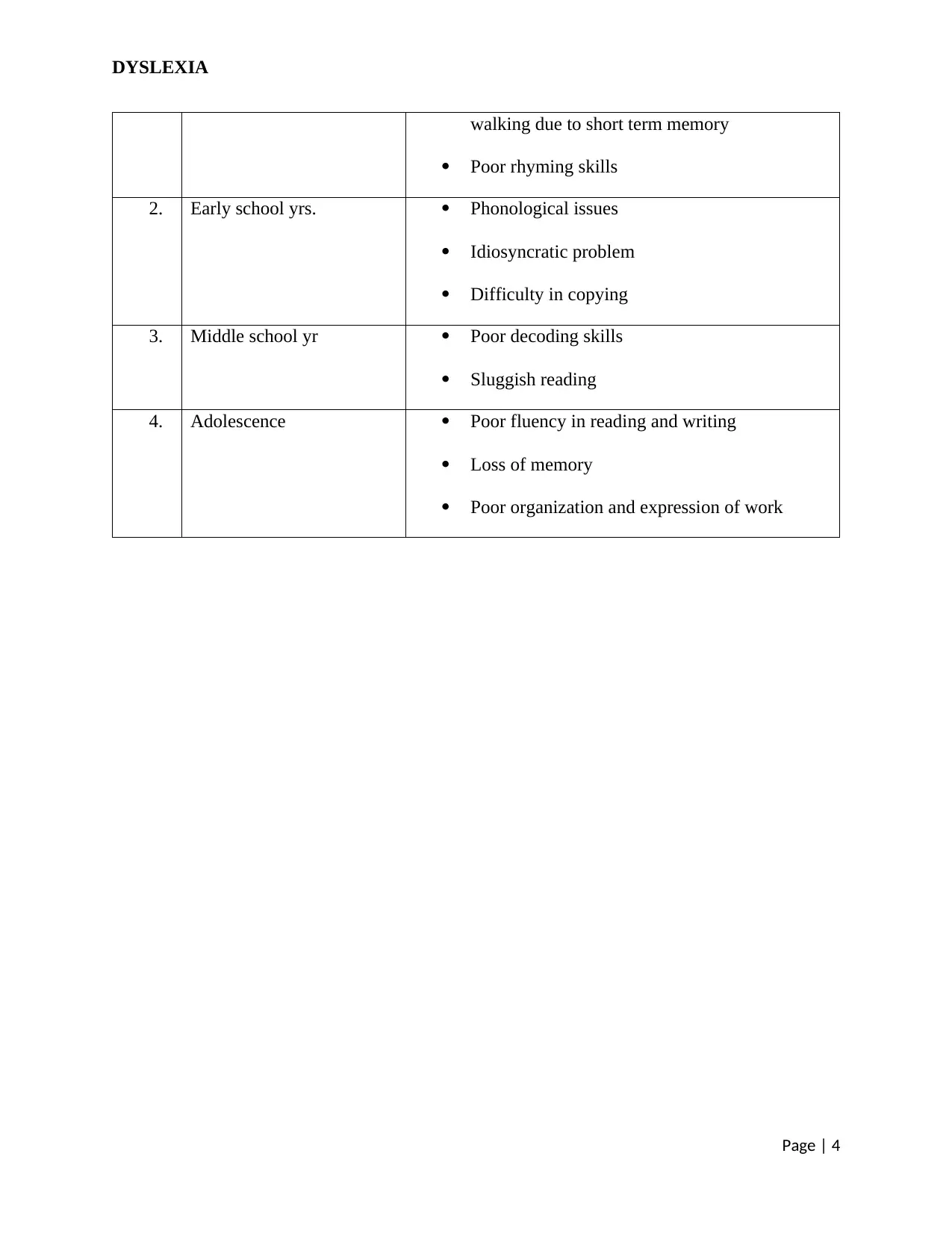
DYSLEXIA
walking due to short term memory
Poor rhyming skills
2. Early school yrs. Phonological issues
Idiosyncratic problem
Difficulty in copying
3. Middle school yr Poor decoding skills
Sluggish reading
4. Adolescence Poor fluency in reading and writing
Loss of memory
Poor organization and expression of work
Page | 4
walking due to short term memory
Poor rhyming skills
2. Early school yrs. Phonological issues
Idiosyncratic problem
Difficulty in copying
3. Middle school yr Poor decoding skills
Sluggish reading
4. Adolescence Poor fluency in reading and writing
Loss of memory
Poor organization and expression of work
Page | 4
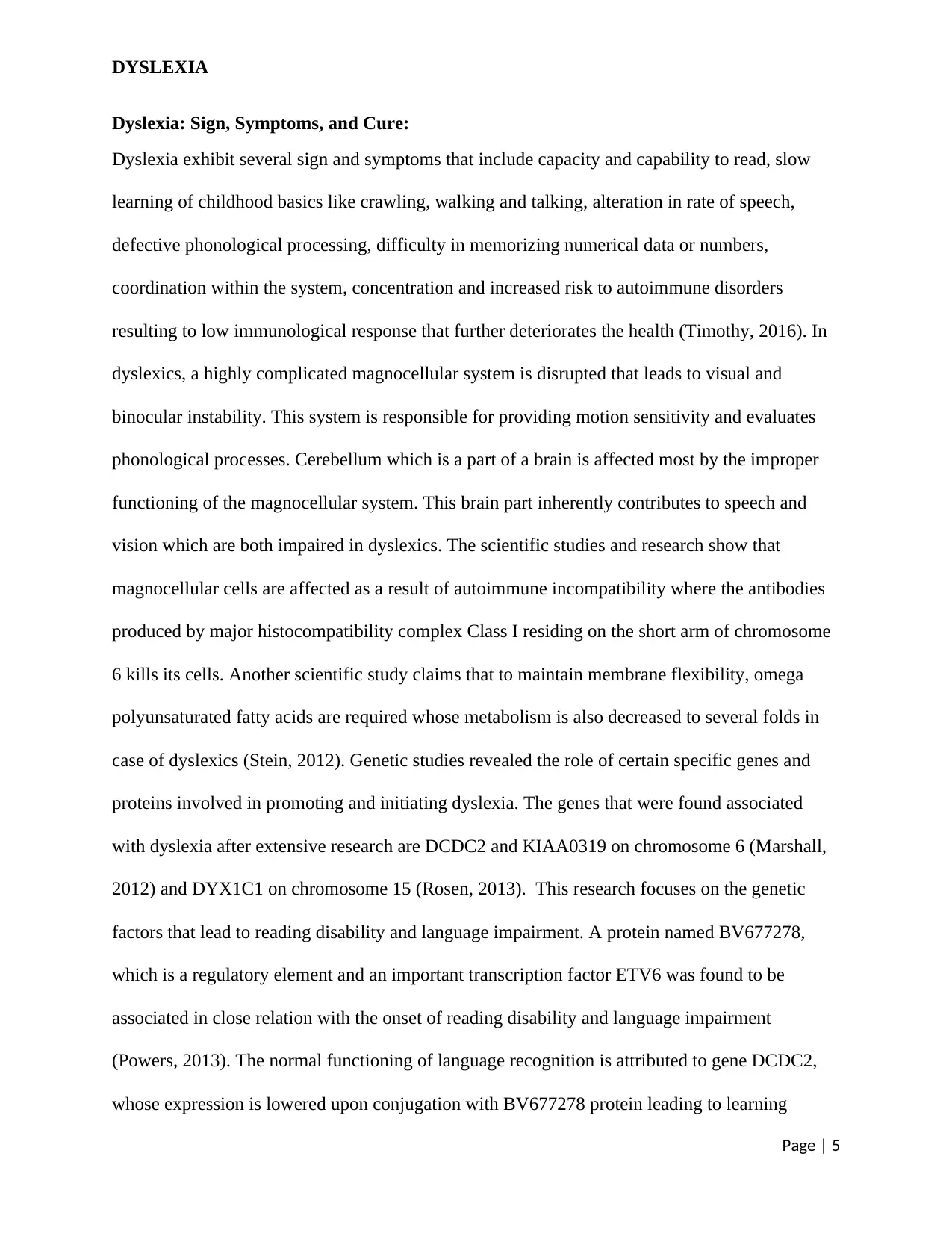
DYSLEXIA
Dyslexia: Sign, Symptoms, and Cure:
Dyslexia exhibit several sign and symptoms that include capacity and capability to read, slow
learning of childhood basics like crawling, walking and talking, alteration in rate of speech,
defective phonological processing, difficulty in memorizing numerical data or numbers,
coordination within the system, concentration and increased risk to autoimmune disorders
resulting to low immunological response that further deteriorates the health (Timothy, 2016). In
dyslexics, a highly complicated magnocellular system is disrupted that leads to visual and
binocular instability. This system is responsible for providing motion sensitivity and evaluates
phonological processes. Cerebellum which is a part of a brain is affected most by the improper
functioning of the magnocellular system. This brain part inherently contributes to speech and
vision which are both impaired in dyslexics. The scientific studies and research show that
magnocellular cells are affected as a result of autoimmune incompatibility where the antibodies
produced by major histocompatibility complex Class I residing on the short arm of chromosome
6 kills its cells. Another scientific study claims that to maintain membrane flexibility, omega
polyunsaturated fatty acids are required whose metabolism is also decreased to several folds in
case of dyslexics (Stein, 2012). Genetic studies revealed the role of certain specific genes and
proteins involved in promoting and initiating dyslexia. The genes that were found associated
with dyslexia after extensive research are DCDC2 and KIAA0319 on chromosome 6 (Marshall,
2012) and DYX1C1 on chromosome 15 (Rosen, 2013). This research focuses on the genetic
factors that lead to reading disability and language impairment. A protein named BV677278,
which is a regulatory element and an important transcription factor ETV6 was found to be
associated in close relation with the onset of reading disability and language impairment
(Powers, 2013). The normal functioning of language recognition is attributed to gene DCDC2,
whose expression is lowered upon conjugation with BV677278 protein leading to learning
Page | 5
Dyslexia: Sign, Symptoms, and Cure:
Dyslexia exhibit several sign and symptoms that include capacity and capability to read, slow
learning of childhood basics like crawling, walking and talking, alteration in rate of speech,
defective phonological processing, difficulty in memorizing numerical data or numbers,
coordination within the system, concentration and increased risk to autoimmune disorders
resulting to low immunological response that further deteriorates the health (Timothy, 2016). In
dyslexics, a highly complicated magnocellular system is disrupted that leads to visual and
binocular instability. This system is responsible for providing motion sensitivity and evaluates
phonological processes. Cerebellum which is a part of a brain is affected most by the improper
functioning of the magnocellular system. This brain part inherently contributes to speech and
vision which are both impaired in dyslexics. The scientific studies and research show that
magnocellular cells are affected as a result of autoimmune incompatibility where the antibodies
produced by major histocompatibility complex Class I residing on the short arm of chromosome
6 kills its cells. Another scientific study claims that to maintain membrane flexibility, omega
polyunsaturated fatty acids are required whose metabolism is also decreased to several folds in
case of dyslexics (Stein, 2012). Genetic studies revealed the role of certain specific genes and
proteins involved in promoting and initiating dyslexia. The genes that were found associated
with dyslexia after extensive research are DCDC2 and KIAA0319 on chromosome 6 (Marshall,
2012) and DYX1C1 on chromosome 15 (Rosen, 2013). This research focuses on the genetic
factors that lead to reading disability and language impairment. A protein named BV677278,
which is a regulatory element and an important transcription factor ETV6 was found to be
associated in close relation with the onset of reading disability and language impairment
(Powers, 2013). The normal functioning of language recognition is attributed to gene DCDC2,
whose expression is lowered upon conjugation with BV677278 protein leading to learning
Page | 5
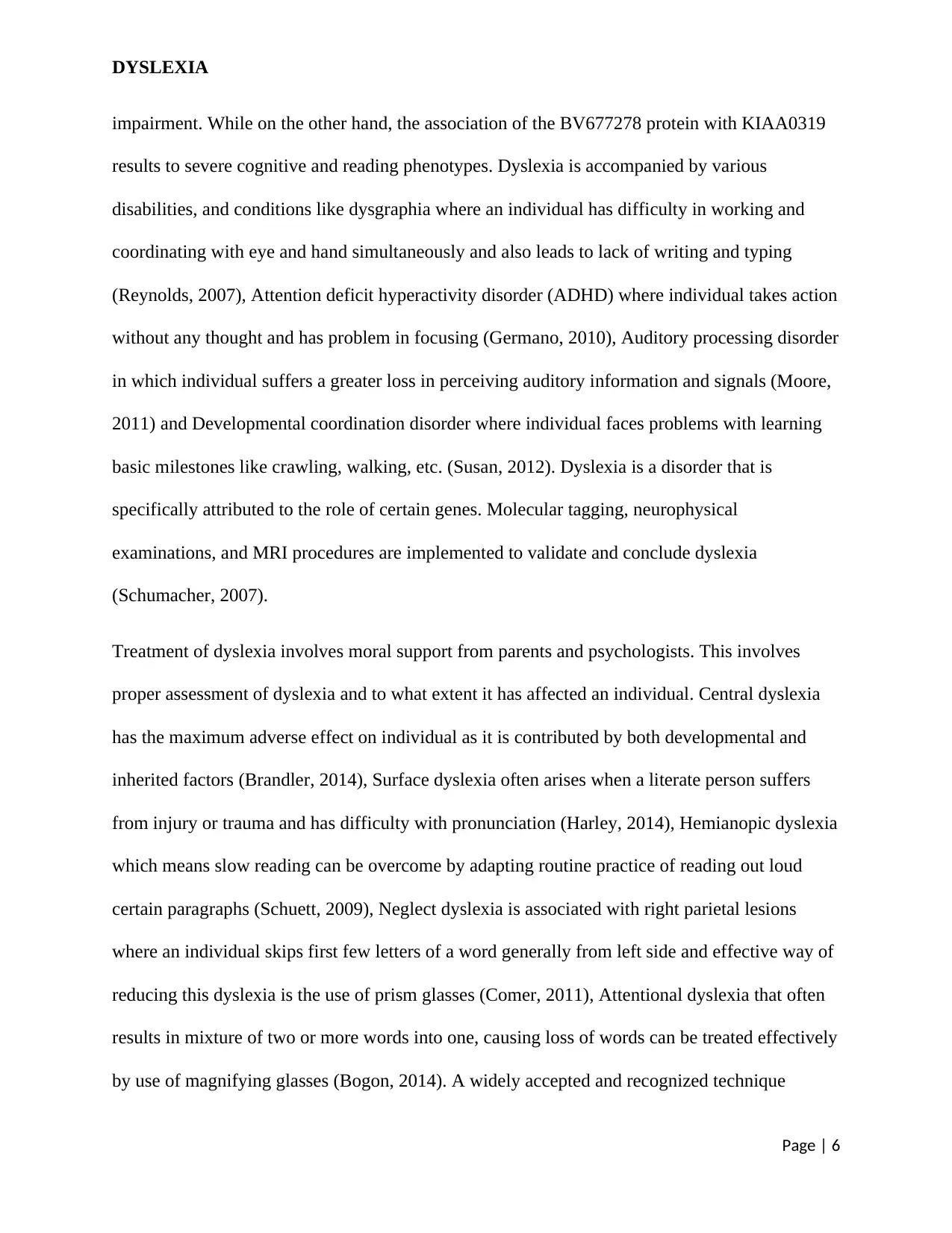
DYSLEXIA
impairment. While on the other hand, the association of the BV677278 protein with KIAA0319
results to severe cognitive and reading phenotypes. Dyslexia is accompanied by various
disabilities, and conditions like dysgraphia where an individual has difficulty in working and
coordinating with eye and hand simultaneously and also leads to lack of writing and typing
(Reynolds, 2007), Attention deficit hyperactivity disorder (ADHD) where individual takes action
without any thought and has problem in focusing (Germano, 2010), Auditory processing disorder
in which individual suffers a greater loss in perceiving auditory information and signals (Moore,
2011) and Developmental coordination disorder where individual faces problems with learning
basic milestones like crawling, walking, etc. (Susan, 2012). Dyslexia is a disorder that is
specifically attributed to the role of certain genes. Molecular tagging, neurophysical
examinations, and MRI procedures are implemented to validate and conclude dyslexia
(Schumacher, 2007).
Treatment of dyslexia involves moral support from parents and psychologists. This involves
proper assessment of dyslexia and to what extent it has affected an individual. Central dyslexia
has the maximum adverse effect on individual as it is contributed by both developmental and
inherited factors (Brandler, 2014), Surface dyslexia often arises when a literate person suffers
from injury or trauma and has difficulty with pronunciation (Harley, 2014), Hemianopic dyslexia
which means slow reading can be overcome by adapting routine practice of reading out loud
certain paragraphs (Schuett, 2009), Neglect dyslexia is associated with right parietal lesions
where an individual skips first few letters of a word generally from left side and effective way of
reducing this dyslexia is the use of prism glasses (Comer, 2011), Attentional dyslexia that often
results in mixture of two or more words into one, causing loss of words can be treated effectively
by use of magnifying glasses (Bogon, 2014). A widely accepted and recognized technique
Page | 6
impairment. While on the other hand, the association of the BV677278 protein with KIAA0319
results to severe cognitive and reading phenotypes. Dyslexia is accompanied by various
disabilities, and conditions like dysgraphia where an individual has difficulty in working and
coordinating with eye and hand simultaneously and also leads to lack of writing and typing
(Reynolds, 2007), Attention deficit hyperactivity disorder (ADHD) where individual takes action
without any thought and has problem in focusing (Germano, 2010), Auditory processing disorder
in which individual suffers a greater loss in perceiving auditory information and signals (Moore,
2011) and Developmental coordination disorder where individual faces problems with learning
basic milestones like crawling, walking, etc. (Susan, 2012). Dyslexia is a disorder that is
specifically attributed to the role of certain genes. Molecular tagging, neurophysical
examinations, and MRI procedures are implemented to validate and conclude dyslexia
(Schumacher, 2007).
Treatment of dyslexia involves moral support from parents and psychologists. This involves
proper assessment of dyslexia and to what extent it has affected an individual. Central dyslexia
has the maximum adverse effect on individual as it is contributed by both developmental and
inherited factors (Brandler, 2014), Surface dyslexia often arises when a literate person suffers
from injury or trauma and has difficulty with pronunciation (Harley, 2014), Hemianopic dyslexia
which means slow reading can be overcome by adapting routine practice of reading out loud
certain paragraphs (Schuett, 2009), Neglect dyslexia is associated with right parietal lesions
where an individual skips first few letters of a word generally from left side and effective way of
reducing this dyslexia is the use of prism glasses (Comer, 2011), Attentional dyslexia that often
results in mixture of two or more words into one, causing loss of words can be treated effectively
by use of magnifying glasses (Bogon, 2014). A widely accepted and recognized technique
Page | 6
Secure Best Marks with AI Grader
Need help grading? Try our AI Grader for instant feedback on your assignments.
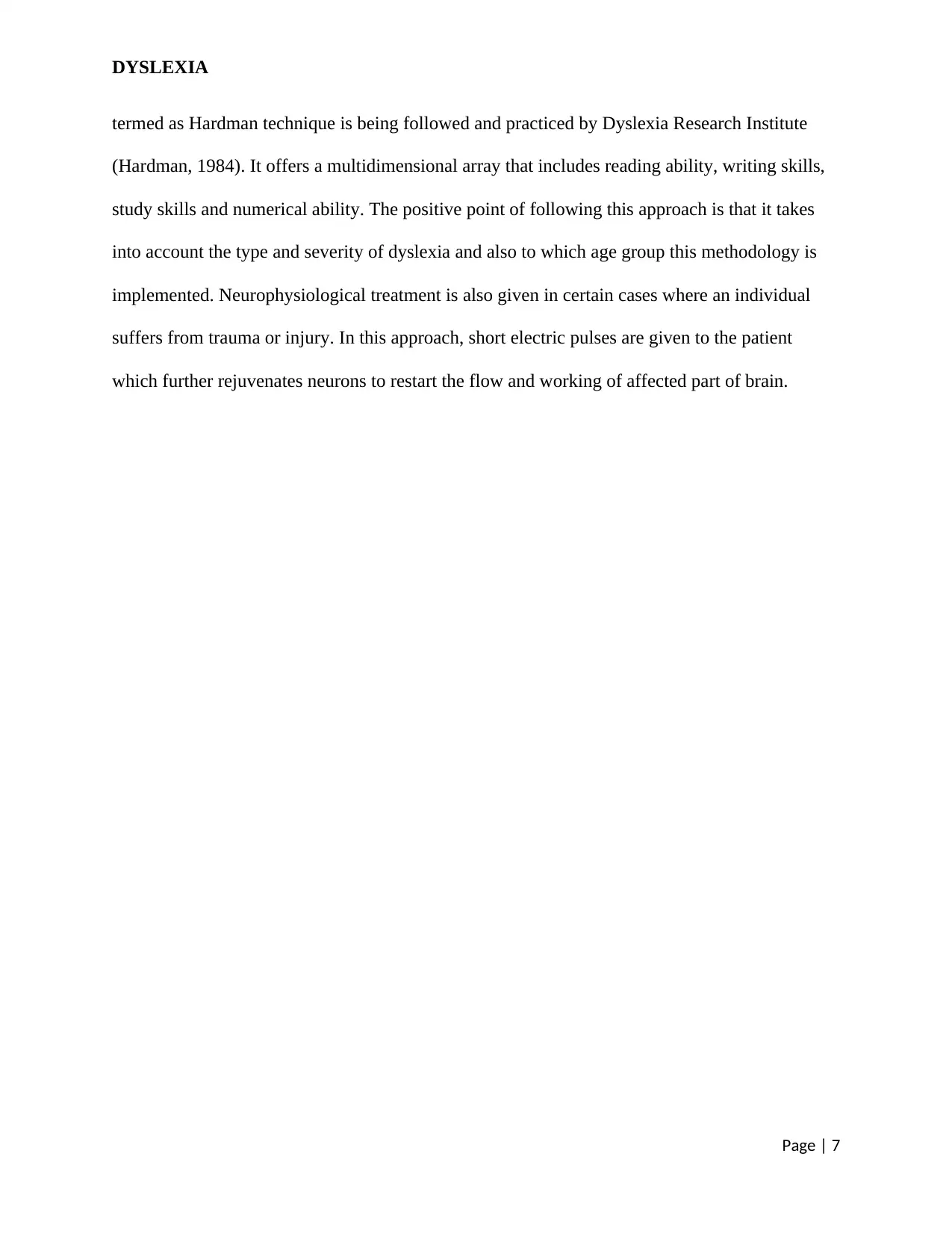
DYSLEXIA
termed as Hardman technique is being followed and practiced by Dyslexia Research Institute
(Hardman, 1984). It offers a multidimensional array that includes reading ability, writing skills,
study skills and numerical ability. The positive point of following this approach is that it takes
into account the type and severity of dyslexia and also to which age group this methodology is
implemented. Neurophysiological treatment is also given in certain cases where an individual
suffers from trauma or injury. In this approach, short electric pulses are given to the patient
which further rejuvenates neurons to restart the flow and working of affected part of brain.
Page | 7
termed as Hardman technique is being followed and practiced by Dyslexia Research Institute
(Hardman, 1984). It offers a multidimensional array that includes reading ability, writing skills,
study skills and numerical ability. The positive point of following this approach is that it takes
into account the type and severity of dyslexia and also to which age group this methodology is
implemented. Neurophysiological treatment is also given in certain cases where an individual
suffers from trauma or injury. In this approach, short electric pulses are given to the patient
which further rejuvenates neurons to restart the flow and working of affected part of brain.
Page | 7
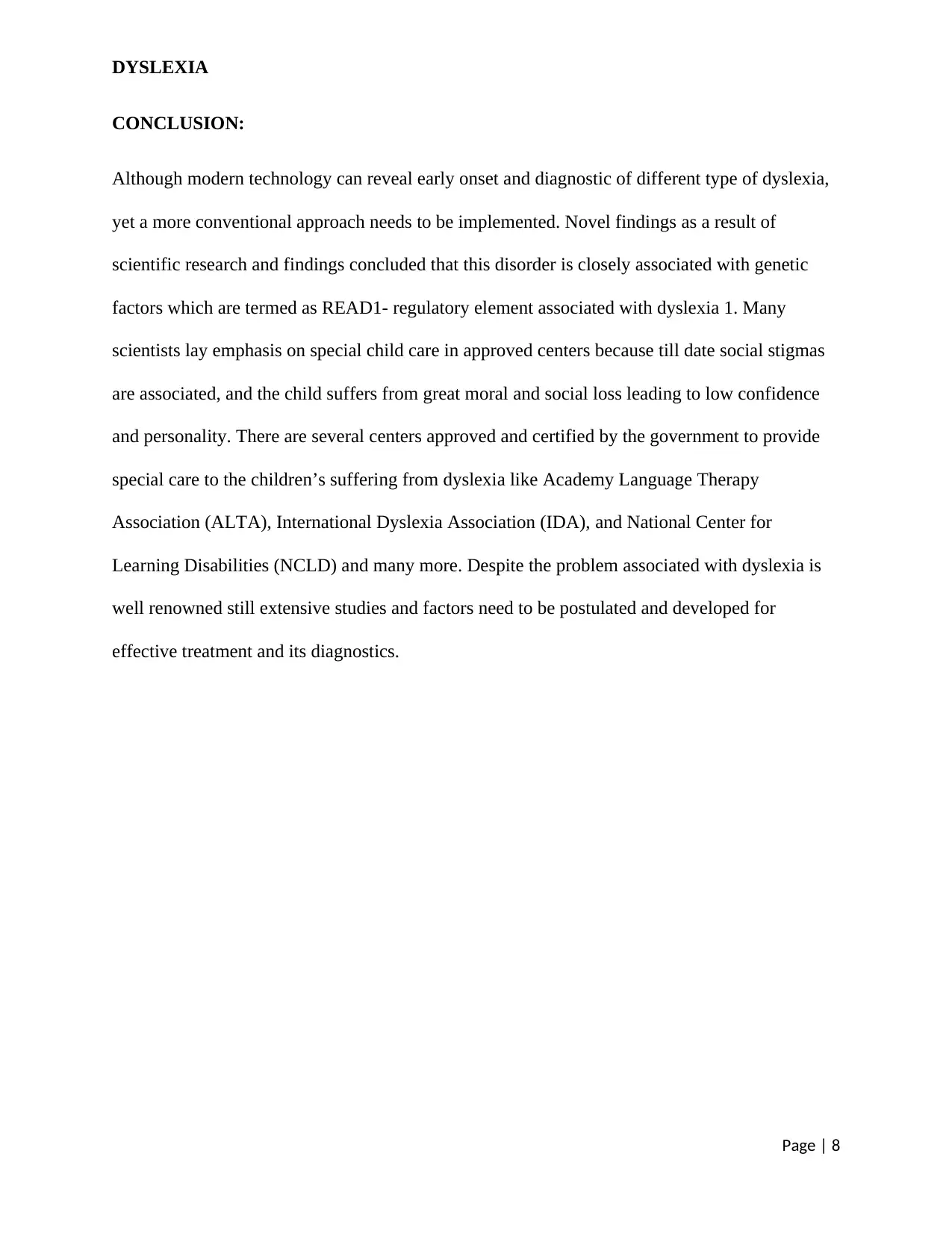
DYSLEXIA
CONCLUSION:
Although modern technology can reveal early onset and diagnostic of different type of dyslexia,
yet a more conventional approach needs to be implemented. Novel findings as a result of
scientific research and findings concluded that this disorder is closely associated with genetic
factors which are termed as READ1- regulatory element associated with dyslexia 1. Many
scientists lay emphasis on special child care in approved centers because till date social stigmas
are associated, and the child suffers from great moral and social loss leading to low confidence
and personality. There are several centers approved and certified by the government to provide
special care to the children’s suffering from dyslexia like Academy Language Therapy
Association (ALTA), International Dyslexia Association (IDA), and National Center for
Learning Disabilities (NCLD) and many more. Despite the problem associated with dyslexia is
well renowned still extensive studies and factors need to be postulated and developed for
effective treatment and its diagnostics.
Page | 8
CONCLUSION:
Although modern technology can reveal early onset and diagnostic of different type of dyslexia,
yet a more conventional approach needs to be implemented. Novel findings as a result of
scientific research and findings concluded that this disorder is closely associated with genetic
factors which are termed as READ1- regulatory element associated with dyslexia 1. Many
scientists lay emphasis on special child care in approved centers because till date social stigmas
are associated, and the child suffers from great moral and social loss leading to low confidence
and personality. There are several centers approved and certified by the government to provide
special care to the children’s suffering from dyslexia like Academy Language Therapy
Association (ALTA), International Dyslexia Association (IDA), and National Center for
Learning Disabilities (NCLD) and many more. Despite the problem associated with dyslexia is
well renowned still extensive studies and factors need to be postulated and developed for
effective treatment and its diagnostics.
Page | 8
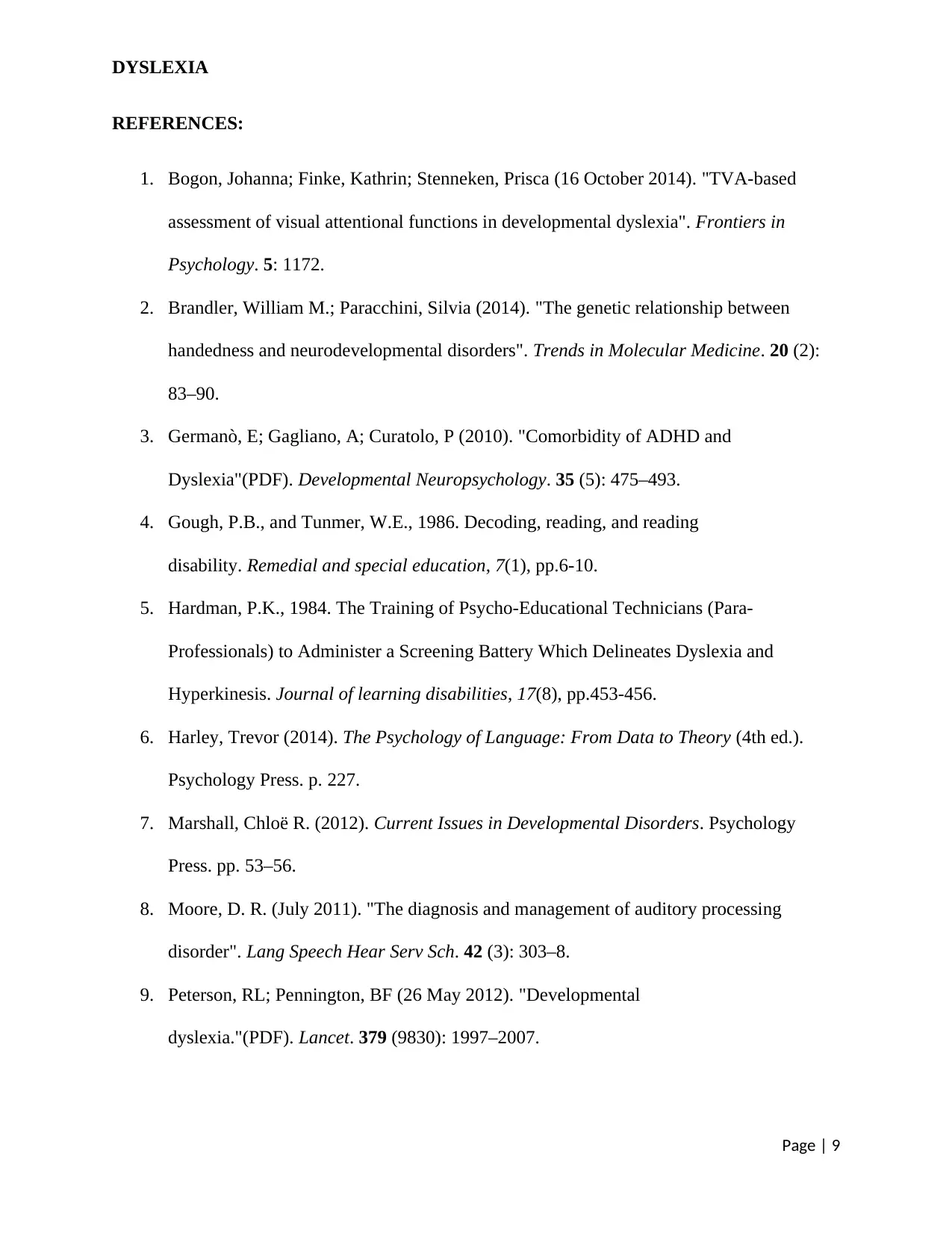
DYSLEXIA
REFERENCES:
1. Bogon, Johanna; Finke, Kathrin; Stenneken, Prisca (16 October 2014). "TVA-based
assessment of visual attentional functions in developmental dyslexia". Frontiers in
Psychology. 5: 1172.
2. Brandler, William M.; Paracchini, Silvia (2014). "The genetic relationship between
handedness and neurodevelopmental disorders". Trends in Molecular Medicine. 20 (2):
83–90.
3. Germanò, E; Gagliano, A; Curatolo, P (2010). "Comorbidity of ADHD and
Dyslexia"(PDF). Developmental Neuropsychology. 35 (5): 475–493.
4. Gough, P.B., and Tunmer, W.E., 1986. Decoding, reading, and reading
disability. Remedial and special education, 7(1), pp.6-10.
5. Hardman, P.K., 1984. The Training of Psycho-Educational Technicians (Para-
Professionals) to Administer a Screening Battery Which Delineates Dyslexia and
Hyperkinesis. Journal of learning disabilities, 17(8), pp.453-456.
6. Harley, Trevor (2014). The Psychology of Language: From Data to Theory (4th ed.).
Psychology Press. p. 227.
7. Marshall, Chloë R. (2012). Current Issues in Developmental Disorders. Psychology
Press. pp. 53–56.
8. Moore, D. R. (July 2011). "The diagnosis and management of auditory processing
disorder". Lang Speech Hear Serv Sch. 42 (3): 303–8.
9. Peterson, RL; Pennington, BF (26 May 2012). "Developmental
dyslexia."(PDF). Lancet. 379 (9830): 1997–2007.
Page | 9
REFERENCES:
1. Bogon, Johanna; Finke, Kathrin; Stenneken, Prisca (16 October 2014). "TVA-based
assessment of visual attentional functions in developmental dyslexia". Frontiers in
Psychology. 5: 1172.
2. Brandler, William M.; Paracchini, Silvia (2014). "The genetic relationship between
handedness and neurodevelopmental disorders". Trends in Molecular Medicine. 20 (2):
83–90.
3. Germanò, E; Gagliano, A; Curatolo, P (2010). "Comorbidity of ADHD and
Dyslexia"(PDF). Developmental Neuropsychology. 35 (5): 475–493.
4. Gough, P.B., and Tunmer, W.E., 1986. Decoding, reading, and reading
disability. Remedial and special education, 7(1), pp.6-10.
5. Hardman, P.K., 1984. The Training of Psycho-Educational Technicians (Para-
Professionals) to Administer a Screening Battery Which Delineates Dyslexia and
Hyperkinesis. Journal of learning disabilities, 17(8), pp.453-456.
6. Harley, Trevor (2014). The Psychology of Language: From Data to Theory (4th ed.).
Psychology Press. p. 227.
7. Marshall, Chloë R. (2012). Current Issues in Developmental Disorders. Psychology
Press. pp. 53–56.
8. Moore, D. R. (July 2011). "The diagnosis and management of auditory processing
disorder". Lang Speech Hear Serv Sch. 42 (3): 303–8.
9. Peterson, RL; Pennington, BF (26 May 2012). "Developmental
dyslexia."(PDF). Lancet. 379 (9830): 1997–2007.
Page | 9
Paraphrase This Document
Need a fresh take? Get an instant paraphrase of this document with our AI Paraphraser

DYSLEXIA
10. Powers, N.R., Eicher, J.D., Butter, F., Kong, Y., Miller, L.L., Ring, S.M., Mann, M. and
Gruen, J.R., 2013. Alleles of a Polymorphic ETV6 binding site in DCDC2 Confer risk of
reading and language impairment. The American Journal of Human Genetics, 93(1),
pp.19-28.
11. Reynolds, Cecil R.; Fletcher-Janzen, Elaine (2 January 2007). Encyclopedia of Special
Education. John Wiley & Sons. p. 771.
12. Rosen, Glenn D. (2013). The Dyslexic Brain: New Pathways in Neuroscience Discovery.
Psychology Press. p. 342.
13. Schuett, Susanne (2009). "The rehabilitation of hemianopic dyslexia". Nature Reviews
Neurology. 5 (8): 427–37.
14. Schumacher, Johannes; Hoffmann, Per; Schmäl, Christine; Schulte‐Körne, Gerd; Nöthen,
Markus M (2007). "Genetics of dyslexia: the evolving landscape". Journal of Medical
Genetics. 44 (5):
15. Snowling, M. J. (2008). Specific disorders and broader phenotypes: The case of
dyslexia. The Quarterly Journal of Experimental Psychology, 61(1), 142-156.
16. Stein, J., 2001. The magnocellular theory of developmental dyslexia. Dyslexia, 7(1),
pp.12-36.
17. Susan J. Pickering (2012). "Chapter 2. Working Memory in Dyslexia". In Tracy Packiam
Alloway; Susan E. Gathercole. Working Memory and Neurodevelopmental Disorders.
Psychology Press.
18. Timothy J. Legg, 2016. PMHNP-BC, GNP-BC, CARN-AP, MCHES.
19. Vellutino, F.R., 1979. Dyslexia: Theory and research.
Page | 10
10. Powers, N.R., Eicher, J.D., Butter, F., Kong, Y., Miller, L.L., Ring, S.M., Mann, M. and
Gruen, J.R., 2013. Alleles of a Polymorphic ETV6 binding site in DCDC2 Confer risk of
reading and language impairment. The American Journal of Human Genetics, 93(1),
pp.19-28.
11. Reynolds, Cecil R.; Fletcher-Janzen, Elaine (2 January 2007). Encyclopedia of Special
Education. John Wiley & Sons. p. 771.
12. Rosen, Glenn D. (2013). The Dyslexic Brain: New Pathways in Neuroscience Discovery.
Psychology Press. p. 342.
13. Schuett, Susanne (2009). "The rehabilitation of hemianopic dyslexia". Nature Reviews
Neurology. 5 (8): 427–37.
14. Schumacher, Johannes; Hoffmann, Per; Schmäl, Christine; Schulte‐Körne, Gerd; Nöthen,
Markus M (2007). "Genetics of dyslexia: the evolving landscape". Journal of Medical
Genetics. 44 (5):
15. Snowling, M. J. (2008). Specific disorders and broader phenotypes: The case of
dyslexia. The Quarterly Journal of Experimental Psychology, 61(1), 142-156.
16. Stein, J., 2001. The magnocellular theory of developmental dyslexia. Dyslexia, 7(1),
pp.12-36.
17. Susan J. Pickering (2012). "Chapter 2. Working Memory in Dyslexia". In Tracy Packiam
Alloway; Susan E. Gathercole. Working Memory and Neurodevelopmental Disorders.
Psychology Press.
18. Timothy J. Legg, 2016. PMHNP-BC, GNP-BC, CARN-AP, MCHES.
19. Vellutino, F.R., 1979. Dyslexia: Theory and research.
Page | 10
1 out of 11
Related Documents
Your All-in-One AI-Powered Toolkit for Academic Success.
+13062052269
info@desklib.com
Available 24*7 on WhatsApp / Email
![[object Object]](/_next/static/media/star-bottom.7253800d.svg)
Unlock your academic potential
© 2024 | Zucol Services PVT LTD | All rights reserved.





